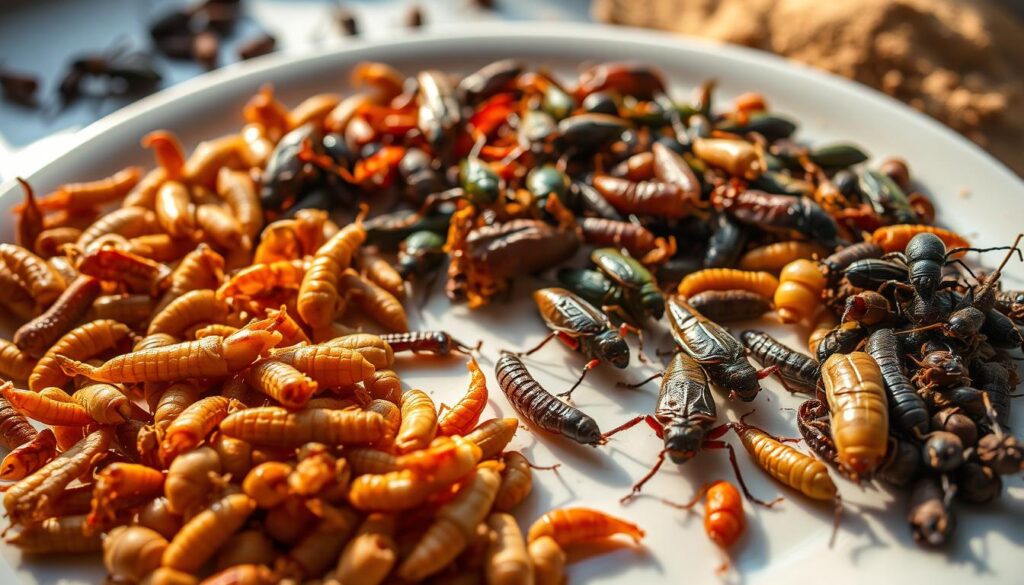The world of food is changing, and edible insects are becoming more popular. Almost two billion people in Asia, Africa, and Latin America have eaten insects for centuries. Now, Americans are starting to try them too.
Entomophagy, or eating insects, is becoming more common. Chefs, nutritionists, and environmentalists see the benefits. They think insects are special.

Insect based food are unique in today’s protein market. Cricket flour has more protein than beef but uses less resources. Mealworms have omega-3s like fish. These foods are not just new; they solve big global problems.
Insect protein is special because it has everything our bodies need. Unlike plant proteins, insects have all nine essential amino acids. They’re also full of vitamins, minerals, and fiber but low in carbs and fats.
This makes them great for athletes, health lovers, and anyone wanting to try new proteins.
Key Takeaways Insect Based Food
- Edible insects have been traditional food for billions of people worldwide
- Insect protein contains all essential amino acids humans need
- Entomophagy offers solutions for sustainable food production
- Cricket flour provides more protein per gram than beef
- Insects require minimal resources to produce compared to livestock
- The market for edible insects is growing rapidly in the United States
The Rising Popularity of Edible Insects
Edible insects are becoming more popular in America. People are now interested in cricket protein and other bug-based foods. This shows a change in how we see food and nutrition.
The bug-based food market is expected to hit $8 billion by 2030. North America is leading the way with a 28% annual growth. This is because more people want protein that’s good for the planet.
From Global Tradition to Modern Trend
For over 2 billion people, eating insects is common. But in the West, it’s just starting to catch on. Thanks to new products and packaging, it’s becoming a trendy superfood.
Market Growth in the United States
In America, more people see insect foods as a real protein option. Since 2018, cricket-based products have seen a 25% annual increase. This is especially true for protein powders and snacks.
Pioneering Companies and Products
Some companies are leading the way in making bug-based foods mainstream. They offer products that make it easy for everyone to try:
| Company | Product Category | Featured Ingredient |
|---|---|---|
| Chapul | Energy Bars | Cricket Flour |
| Exo | Protein Bars | Cricket Powder |
| Chirps Chips | Tortilla Chips | Cricket Protein |
| Seek Food | Baking Flour | Cricket Powder |
Exceptional Nutritional Profile and Unique Properties of Insect Proteins
Edible insects are a nutritional powerhouse. They offer protein content similar to beef, with crickets having up to 65% protein by dry weight. They also have all nine essential amino acids for good health.
Insects are more than just protein. They are rich in minerals like iron, zinc, and calcium. These levels are often higher than in traditional meats. Their complete amino acid profiles make them better than many plant proteins.
Unique Properties That Set Insects Apart
Edible bug protein has special nutritional components not found in regular foods:
- Chitin – a prebiotic fiber that promotes gut health
- Lauric acid – similar to what’s found in coconut oil
- Rich omega-3 fatty acid profiles
- Exceptionally high B12 content (rare in non-animal foods)
The functional properties of insect proteins offer food scientists exciting new possibilities for creating nutritious products with minimal environmental impact.
Breaking Down Common Misconceptions
Many think Insect based food are low in nutrients or taste bad. But, properly processed edible bugs are clean protein with neutral flavors. They take on seasonings well and keep their protein quality even after processing.
Safety concerns are also a myth. Commercial insect farms follow strict protocols. They produce food that meets the same safety standards as traditional protein sources. The nutritional benefits of insects make them a great addition to a balanced diet.
Environmental Benefits: A Sustainable Food Solution
Insects are a promising food solution for our growing world. They have big environmental benefits over traditional farming. Plus, they provide quality nutrition.
Reduced Carbon Footprint
Insect farming is much better for the environment than raising livestock. Crickets, for example, produce 100 times less greenhouse gases than cattle. This makes Insect based food a great choice for those wanting to reduce their environmental impact.
Water Conservation Advantages
Insect farming uses much less water than traditional protein sources. It takes just one gallon of water to produce one pound of cricket protein. In contrast, beef needs nearly 2,000 gallons. This makes insects a water-efficient choice, especially in areas with water scarcity.
Land Use Efficiency
Insects can be farmed in small, vertical spaces. A cricket farm of 1,300 square feet can produce as much protein as 1-2 acres of cattle pasture. This saves land and allows for protein production near cities.
Minimal Feed Requirements
Insects are very efficient at converting feed into protein. They need only 2 pounds of feed to produce 1 pound of edible weight. This is much less than cattle, which need 25 pounds. Many species also eat organic waste, turning food waste into valuable nutrition. This creates a circular food system with many environmental benefits.
Culinary Versatility and Distinctive Flavors of Edible Insects
Edible insects add a surprising twist to American food. They are packed with protein and offer unique flavors. This makes them perfect for both bold and classic dishes.
Cricket: The Gateway Insect
Cricket flour is a great start for those new to insect food. It tastes like toasted seeds and is easy to mix into recipes. Try it in pancakes for a protein boost with a familiar taste.

Cricket flour is also great in cookies and brownies. It adds nutrition without changing the taste. Its earthy flavor pairs well with chocolate and nuts.
Mealworms: Nutty and Versatile – Insect based food
Mealworm protein has a walnut-like taste. It’s good in both sweet and savory dishes. Roasted mealworms add crunch to salads, while ground ones enrich pasta sauces.
Mealworms are perfect for energy bars and protein balls. They mix well with dates, coconut, and dark chocolate. Even those who are hesitant to try them often enjoy these snacks.
Black Soldier Fly Larvae: The Nutrition Powerhouse
These insects have a mild taste, making them great for adding nutrition without changing the flavor. They’re soft and work well in smoothies and dips. Chefs also use them in pasta dough for a protein boost, Insect based food.
Edible insects are more than just a novelty. They can turn regular meals into nutritious ones. With a little creativity, they can become a staple in American cooking, Insect based food.
From Farm to Table: How Edible Insects Are Produced
Insect farming today is far from old-school livestock operations. These modern farms have special setups for the right temperature, humidity, and light. This is key for the insects to grow well. Cricket farms use vertical systems to save space and reduce land use, Insect based food.
The journey starts with breeding colonies that lay eggs. After hatching, young insects eat special feed made from plants. This method is very water-efficient, needing much less water than raising cattle for the same amount of protein, Insect based food.
Harvesting is done carefully to keep quality and ethics high. Insects are picked at the best time and then frozen quickly. This ends their life humanely. After that, they are cleaned, heated to kill bacteria, and ready for eating, Insect based food.
Many farms open their doors to visitors. These tours show how insects are raised and processed in clean, controlled areas. Farmers check everything closely, testing for bad stuff and making sure the insects are healthy, Insect based food.
The last steps are packaging the insects whole, grinding them into powder, or adding them to food. This shows the industry’s dedication to sustainable farming. It saves resources and gives people a healthy, eco-friendly protein choice, Insect based food.
Regulatory Landscape and Food Safety Standards
Edible insects are becoming more popular in America. It’s important to know the rules that keep them safe. The U.S. has strict rules to protect people and support new food ideas, Insect based food.
FDA Guidelines for Edible Insects
The FDA sees bugs as food, just like fruits and veggies. Some bugs, like crickets and mealworms, are safe to eat. But, they must be labeled well because they can cause allergic reactions, Insect based food.

To make sure bugs are safe, they go through special treatments. They are tested for harmful substances before they can be sold. This makes sure they are good for people to eat.
Quality Control in Insect Farming – Insect based food
Keeping insects safe involves watching them closely from start to finish. Here’s how:
- They eat only organic food.
- They are tested for harmful germs.
- They are kept dry to avoid mold.
- Every batch is tracked.
Top insect farms in America follow strict rules. They use systems like HACCP to ensure their food is safe. This makes people feel good about trying new Insect based food.
Overcoming the “Ick Factor”: Psychological Barriers and Solutions
Many Americans feel a strong dislike when thinking about eating insects. This feeling comes from how we view insects as food. It’s a big obstacle to accepting insects as a food source in Western societies. Understanding this feeling is the first step to changing our minds.
Cultural Perspectives on Entomophagy
Our food choices are shaped by culture. While some Americans might find the idea of eating crickets off-putting, others see insects as tasty treats. In Mexico, grasshoppers are a common snack. Thai markets sell fried insects by the bag.
These examples show that our dislike for insects isn’t natural. It’s something we learn from our culture.
Strategies for First-Time Insect Eaters
Getting over the fear of new foods takes careful steps. Studies show that how food is presented and how familiar it is can make a big difference. This is especially true for Insect based food.
- Start with processed products like cricket flour cookies where insects aren’t visible
- Pair insect ingredients with familiar flavors you already enjoy
- Attend tasting events specifically designed for newcomers
- Learn about nutritional benefits to create positive associations
- Try insects prepared by professional chefs who understand flavor profiles
Accepting insects as food often starts with small steps. Many people find that once they get past their initial hesitation, they enjoy the flavors. The goal is to create positive experiences that help us see insects in a new light.
The Future of Insect based food: From Niche to Mainstream
The future of insect food is exciting. The insect protein market will soon be a big part of our food world. Companies are making it easy to add sustainable protein from insects to our meals.
Insect based food are becoming more common in stores. They’re moving from specialty shops to regular supermarkets. This means more people can try them, thanks to better prices and easier access.
Insects could help solve food security issues and offer new protein choices. American food makers are working on using insects in new ways. They aim to make food better for us and the planet.
If you want to try Insect based food, start slow. Choose options that feel right for you. By doing this, you help make our food system better and more varied.
FAQ
What makes Insect based food special?
Insect based food are special because they offer a new, nutritious, and sustainable protein source. They are gaining popularity worldwide, including in the United States. These foods are not only traditional in many cultures but also offer unique nutritional, environmental, and culinary advantages.
How has the popularity of edible insects grown in the United States?
The popularity of edible insects in the United States has grown a lot in recent years. It has moved from a global tradition to a modern trend. The US edible insect market has seen a lot of growth, with companies introducing many insect-based products. This makes insect protein more accessible to American consumers.
What are the exceptional nutritional properties of insect proteins?
Insect based food have a unique nutritional profile. They are a rich source of complete, high-quality protein. Insects often have more protein than beef or chicken. They also provide essential minerals, B vitamins, and beneficial fatty acids, including omega-3s.
Insects contain chitin, a prebiotic fiber that supports gut health. This makes them a truly functional food option.
What are the environmental benefits of insect farming?
Insect farming has big sustainability advantages over traditional livestock production. It has a much lower carbon footprint, uses less water, and is more land-efficient. Insects can convert organic waste into high-quality protein, helping address food waste issues.
How can edible insects be incorporated into American cuisine?
Edible insects are surprisingly versatile and offer unique flavors. Crickets have a mild, nutty taste and work well in baked goods and protein shakes. Mealworms have an earthy, nutty profile and pair well with both sweet and savory dishes.
Black soldier fly larvae are known for their exceptional nutritional density. They can be used in various recipes to appeal to American palates.
How are edible insects produced and what safety standards are in place?
Edible insects are produced in modern, professional farming facilities. These facilities maintain strict hygiene protocols and comply with food safety regulations. The farming process is carefully controlled to ensure the quality and cleanliness of the final products.
Insect based food in the US market must adhere to the same standards as conventional foods. This includes proper allergen labeling and testing for contaminants and pathogens.
How can people overcome psychological barriers to try Insect based food?
Overcoming the “ick factor” associated with insect consumption can be a challenge. Food preferences and aversions are often culturally constructed. However, exposure, education, and presentation can significantly impact acceptance.
Practical strategies for first-time insect eaters include starting with familiar forms like baked goods made with cricket flour. Choosing well-processed products where insects are not visually identifiable can also help. Pairing insects with familiar flavors can ease the transition.
Source link
- https://www.usda.gov/about-usda/news/blog/insects-dinner-potential-tool-toolkit-achieve-global-food-security
- https://portal.nifa.usda.gov/web/crisprojectpages/1003524-low-crawling-fruit-high-quality-clean-sustainable-protein-created-from-insects.html
- https://www.usda.gov/about-usda/news/blog/2023/05/18/biochemist-turns-insect-hobby-successful-research-business-usda-funding
- https://www.ars.usda.gov/oc/dof/harvesting-agricultures-natural-insect-farms/
- https://www.usda.gov/about-usda/news/blog/2022/06/22/buzz-about-pollinators
- https://www.usda.gov/media/blog/2020/08/21/promoting-pollinators-agroforestry
